dating akhnaton
Timing Akhenaten
Léo
Dubal
VLA, virtual laboratory for archaeometry
dubal (at)
archaeometry.org
Abstract:
Evidences for an exact
datation of heretic Pharaoh AKHENATEN,
are presented,
based on a critical repertory of NM, New Moon days
(including
Solar eclipses, though symbolically "No
Moon-days"):
birth, short after NM-day: -1351.08.15,
coronation on NM-day:
-1341.11.22,
wedding :
-1338
fundation Akhetaten :
-1336.03.02
death at the
age of 27: -1324
Introduction
The
chronology of the Amarnian Heresy presented by Nobel prize winner 1988
Naguid Mahfouz in
his historic novel "Dweller
in Truth",
appears three decades later
as surprinsingly far from the one presented here.
A key-element though remains true:
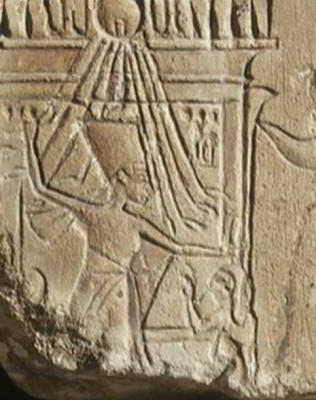
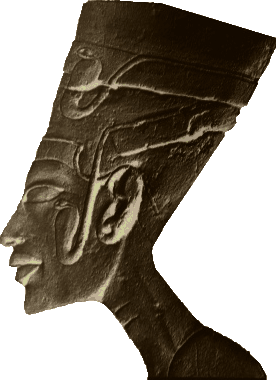
Queen Nefertiti , and
not Pharaoh Akhenaten,
has been the invincible
ruler with raised arm
see http://www.archaeometry.org/den.htm
To
establish the Chronology of Ancient Egypt,
one of the first
researchers having fully recognized
the prime importance of the Sun in this civilisation, is late William
McMurray
(see http://www.egiptomania.com/EEF/EEFLibrary5.html).
The days when only the sun was visible
in the sky,
which deserve to be
called "No Moon days",
appeared to have been chosen for important events.
( New Moon occurrences are listed on imcce site),
Solar eclipses were perceived as special "omen",
good or bad, if partial or total.
Summer
solstices, when the Sun shines at longest must have
been
considered worth of the greatest devotion,
e.g. the erection of the
Giza pyramids,
see http://www.archaeometry.org/sphinxEN.htm
While we identified the role of the summer solstice zenith in
Elephantine,
in connection with the "expected" start of the
flooding of the Nile,
in the launching of the Egyptian calendar,
see http://www.bibalex.org/eclipse2006/CultureLectures.htm
with the greatest satisfaction, we recently discovered that
another physicist, reached, independently of us, just the same
conclusion:
see Juan Antonio BELMONTE AVILES " Some open questions
on
Egyptian calendar: an astronomer's view" TdE 2 (
2003) pp.
23-25 ,
Timing Solstices
In the Northern
Hemisphere, the 5'200 year old
Newgrange's 19 meter long passageway testifies that,
the point of retrogression
of the Rising
Solar Fire in its run southwards
has been
celebrated as the beginning of the (365 ¼ day
long) year,
but, in absence of a writing code,
this accurate solstitial mark did NOT give rise to any known
calendar.
In Ancient Egypt
( in Syene, just at Tropic of
Cancer),
the story of Eratostene, seeing the bottom of his well illuminated
on summer solstice day, tells us about an
alternate paradigm:
shadowless summer
solstice zenith
is obviously the
most salient feature.
As shown by the magnificent sunset picture
taken by Juan Antonio BELMONTE,
on June 21st, 2006, the megalithic landscape built around
the Sphinx of Gizeh,
see http://www.archaeometry.org/sphinxEN.htm,
testifies for the celebration
of summer solstice, too.

It depicts the hieroglyph akhet

which has been interpreted
by CHAMPOLLION as
"horizon".
Let us
notice that the summer solstice,
in the year of the Nicaea's Council, occurred
on +325.06.22/05:36. or, at noon, JDssNicaea
= 1'839'937.
If one now calculates the date of the
( the conversion
from a given Julian Day
to a date of the Ancient
Egyptian Calendar
is
available
on http://www.nabkal.de/kalrech8.html.)
1st Summer Solstice occurence at the
new city of Akhetaten, 1661
years earlier
:
JDssAkhetaten = JDssNicaea
- 16.61 [cy] . λ-1 = JD 1'233'269.5,
this corresponds to -1336.07.05 in the Julian
Calendar, instead of 06.22.
One should therefore, add
to the date of the Julian Calendar:
12 days for RAMSES II's period,
13 days
for AKHENATEN's period,
24
days
for DJOSER's .
DJOSER's name is usually
associated with the first large pyramid.
Though, this monument is an achievement of the Great Vizir IMHOTEP.
Joseph DAVIDOVITS even suggests that IMHOTEP
introduced geopolymers for manufacturing
agglomerated limestone...
Most probably, IMHOTEP is the one to be thanked for having
launched
47 centuries ago,
on summer solstice day, a 365 day long
cyclic calendar.
This day was called: 1st day of Thot,
1st month of the
inundation season Akhet.
IMHOTEP'
Calendar
Some might argue
that the coincidence with IMHOTEP
is fortuitous...
On the Famine Stele erected under the Ptolemaic era
and located on Sehel Island in the Nile near Aswan,
is reported the following founding myth (i.e. for the Egyptian
calendar... &
State)
It speaks of a 7 year period of drought and famine during the reign of
the 3rd dynasty pharaoh Djoser.
The king had a dream. He sees the God Knum, who promises an
end to the famine if the king grants
his temple at Elephantine with all his wealth...
Good choice indeed: in the tropical Island of Elephantine, the summer
solstice, a "no-shadow event",
matches pretty well with the beginning of the Nile's
inundation
season "Akhet".
The Ancient Egyptian Calendar Year has
3 seasons of 120 days each + 5 additional days.
Each seasons is made up of 4 months of 30 days
each.
there exists a ship's log written on a recycled papyrus,
i.e. the back of Hymns to AMUN (Papyrus
Leyden I 350).
It reports that

on 27 Peret II of the 52nd regnal year, the "New
Moon Festival" took place.
52nd must refer to the long reign, from
-1290.06.03 (27 Shemu III) to -1223, of
RAMSES II, while, according to the IMCCE: http://www.imcce.fr/fr/grandpublic/phenomenes/phases_lune/index.php
& http://www.nabkal.de/kalrech8.html.
a New Moon occurred on -1238.12.22 ( JD 1 269 234),
i.e. on 27 Peret II .
So 1
Akhet I (
1st day of month Thot) must have been 176 days earlier on JD
1'269'058
(-1238.06.29).
The previous correspondence between Summer Solstice and
1 Akhet I
was on -1257.07.04 (and for
the 3 years before) and then
1'508 years
earlier, on -2765.07.16.
Considering
that Summer solstice AND
New Moon occurred on -2762.07.16,
another
obvious
possibility for 1 Akhet
I is: -2762.07.15.
Georges BONANI & al. in
"Radiocarbon Dates of Old and Middle
Kingdom Monuments in Egypt", Radiocarbon, 43, 2001, p.1313
reported their Calibrated Dates from AMS
measurements of straw and reed
of adobe bricks from 3m above the 4th tier of the Saqqara Step Pyramid:
-2741 +/- 74
with a confidence level of 80%, in complete agreement with
our findings.
That contrasts sharply with the so-called historical range
around year
-2650
Solar Pharaoh vs. Solar Eclipses
The first Pharaoh who might have claimed
to be the 1st Atenist
is AMENHOTEP III
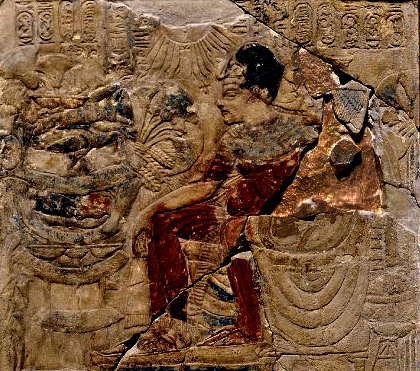
Though this stela with the pharaoh and his spouse TIY
is probably from the amarnian period,
in our opinion, it depicted the partial (60%) solar eclipse over Thebes
on
NM day -1351.08.15,
a short time before AMENHOTEP IV's birthday.
The son of AMENHOTEP III and TIY has been crowned,
at
the age of 10, on
1Peret I ,
i.e. NM -1341.11.22. The scene is depicted in Kheruef's
tomb:
the young pharaoh being chaperoned
by
his mother TIY.
The young Pharaoh attempted very early
to
foster the cult of Aten.
The last mention of the Amun priest MAYA is
dated
11 Akhet III, i.e. -1337.10.01.
With 13, ca.
-1338.08, at the end of reignal year III, ,
he married
Nefertiti, just before the celebration of his first
Jubilee on -1338.11.21.
During reignal year IV a
solar eclipse
occurred on NM -1337.05.14, see SAROS
A
possible depiction of the event has been photographed by
George S. JOHNSON. It is the unique colored representation of
ATEN,
in
the unfinished tomb of MERYRE I, who
was called the
"Great Seer of ATEN".
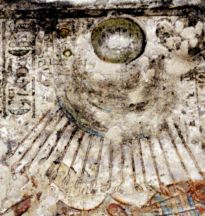
Typical of the pre-HIPPARCHUS'
No Moon / eclipsed Sun confusion,
crescents are spontaneously painted in cold colour,
as
first noticed by Brigitte
QUILLARD.
The Pharaoh must have seen this solar
eclipse at Thebes (E32.6 / N25.7),
where the magnitude has been 0.94,
see http://www.archaeometry.org/saros.pdf
and interpreted it as a personal message
from
"his father ATEN".
(a total solar
eclipse would probably have frighten him to death...)
The Pharaoh decided then to change
his name into AKHENATEN,
hiding, under the monotheistic cult of the faceless
Solar Disk ATEN,
the cult of his own personality.
-1337,
MERITATEN, his first
daughter, was born.
(The mother, NEFERTITI, was probably also only
12 year old,
the biological lowest limit for giving birth to an healthy child)
And after a gestation time of 10 New Moons,
at the site
@
E30.9046 /N27.6701,
now called Tell El-Amarna,
(a place where the -1337.05.14 solar
eclipse had been total for 4 minutes
http://xjubier.free.fr/site_pages/solar_eclipses/xSE_GoogleMapFull.php?Ecl=-13370514&Acc=2&Umb=1&Lmt=1&Mag=0&Lat=27.6701&Lng=30.63538&Zoom=7&DdT=1
250 km North of Thebes,
about half way to the Northern end of his kingdom,
in the most occidental part of the Nile river,
AKHENATEN created a new
capitol: AKHETATEN.
The
Sphinx with a Pharaoh's face has been again popular during
the 18th Dynasty.
On front walls,
AKHENATEN let himself depicted as a
sphinx
solving the riddle of ATEN
(the only "hand signal" given by ATEN to
AKHENATEN,
i.e., to be interpretable as such, is, to my
understanding the
Solar
Eclipse
he saw in Thebes).
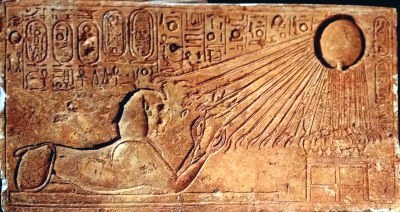
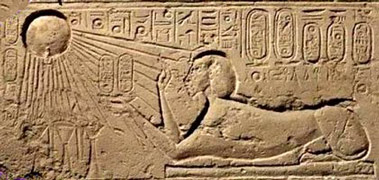
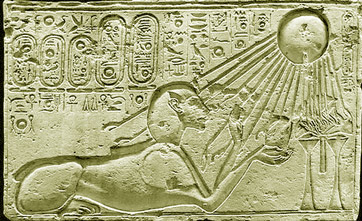
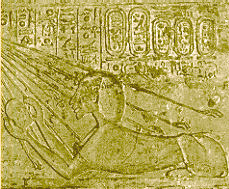
The text is
very clear: " Let him build
the Horizon of Aten in Akhetaten"
While CHEOPS,
in order to"stage akhet" at the summer solstice sunset,
had to plan
the building of a megalithic landscape
on the Giza-plateau,,
13 centuries later, AKHENATEN followed a far easier way:
At the 10th No Moon occurence after the solar
eclipse
(i.e. after a fair gestation time !),
AKHENATEN "staged akhet" at sunrise,
in a suitable wadi (half-way
between Thebes and Memphis)
AKHENATEN
inaugurated
in
AKHET-ATEN
("the place where Aten rises" what
will become, in ryVII, his
new capitol).
the first temple dedicated to ATEN,
According to Marc GABOLDE,
in "Akhenaton,
Du mystère à la
lumière" (Découvertes
Gallimard 2005),
the boundary stele mentioned
:
"at dawn of 13 Peret IV, regnal
year V".
Marc GABOLDE demonstrated his point with
his
breath-taking picture,
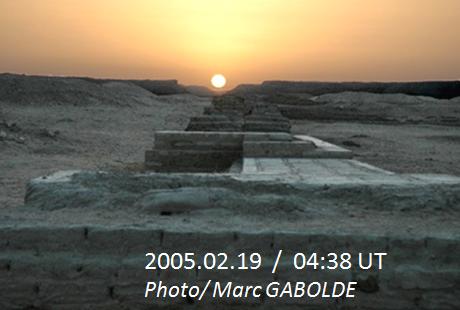
that very day, the rising sun, appears
there....."akhet-like".
13 prt IV , ryV, i.e.
-1336.03.02,
29 days before the spring
equinox.
Let us note
that the
alignment of monuments on the
rising sun 4 weeks before the
spring equinox
is part of the "Amarna
Heritage",
e.g. in Abu Simbel
(illumination of the shrine of
the temple of Ramses II ).
DNA analysis, have recently provided
further new hints on the Amarna royal family:
AKHENATEN appears as the father of TUTANKH-ATEN,
whose mother might have been NEFERTITI,
or TUT's 9 years old sister MERITATEN !
She might be the one carrying her baby ( later known
as TUTANKH-AMON)
who is depicted in the tomb of MAKETATEN around year -1329
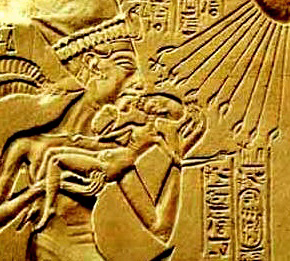
The fondling scene between AKHENATEN
and his oldest daughter MERITATEN
(in front of Nefertiti and his two younger daughters)
brings light onto the royal family life...
Short remark, à
la JUNG,
on the fascination of Sigmund FREUD for AKHENATEN:
The triangle Sphinx-AKHENATEN
& MERITATEN
sounds more like
the incestuous triangle
Psychoanalysis-FREUD & ANNA
than the triangle
Sphinx-JOCASTA & OEDIPUS !!!
With a 9 year old mother, TUT
had no chance to procreate viable children !
Indeed only mummies of two fetuses are attributed to be the fruits of
the union of
TUTANKH-ATEN and his 5 years older sister ANKHESEPA-ATEN !
According to Marc GABOLDE, AKHENATEN died
in the 17th
year of his reign,
shortly after the death of Queen NEFERTITI .
This
Chronology of the
Amarna Period, is comforted by
a letter from Hittite's King MURSILI II in his ryVII to General
HOREMHEB,
during, presumably, reignal year II of Pharaoh Aï.
In his ryX, MURSILI II mentioned a "bad omen", which
most probably refers to the solar eclipse over Hattusa, on
-1311.06.24.
Tentative
Chronology of the Amarnian Heresy
Out of those data
one might attempt to sketch an
overview of this most
peculiar period of Ancient Egypt
| -
1351.08.15 |
|
20 Akhet I |
Solar
eclipse (70% over Thebes) followed
by
Birth Amenhotep IV |
| -1341.11.22
NM |
ry I
|
1 Peret I
|
Crowning Amenhotep
IV
(10
years old,
depicted with his
mother TIY in Kheruef's tomb) |
| -1338.08.
|
ryIII |
|
Wedding AmenhotepIV (13 yr)- Nefertiti
|
| -1338.11.21 |
ryIII / IV |
1 Peret I |
Celebration
1st Jubilee |
| -1337.02.07 |
ry IV |
19 Peret III |
Amenhotep
IV changes into Akhenaten |
| -1337.05.14 |
ryIV |
25
ShemuII |
Solar eclipse 94%
over Thebes
followed
by Birth
Meritaten
|
| -1337.10.01
|
ry IV |
11
Akhet III
|
last mention
Maia
(1st priest of AMUN at Karnak) |
| -1336.03.02
|
ry V |
13
Peret IV |
Foundation
Akhet-Aten
|
| -1336.04
|
ry V |
|
Birth Maketaton
|
| -1335.03.02
|
ry VI |
13
Peret IV |
Anniversary AkhetAten
Birth Ankhesepaaten
|
| -1334.03.13 |
ry VII |
24
Peret IV |
Solar eclipse 74%
over Akhetaten
followed
by final move to AkhetAten / Family
picture to 5 |
-1334.11.27
-1333.11.19 |
ry
VIII |
8 Peret I
30 Akhet IV |
Repetition
of Oath
Another Oath |
| -1331.12.30 |
ry XI |
12
Peret II |
Solar eclipse 61%
over Akhetaten |
| -1330.12.26
|
ry
XII |
8 Peret II
|
Reception (in presence of the Pharao's
six daughters) |
| -1329
|
ry XIII
|
|
Birth of Tutankhaten / Death Maketaten |
-1324.01
-1324.07 |
ryXVII
|
|
Death
Nefertiti
?
Death
Akhenaten
(27y) |
-1324.07
-1323.07 |
ry
I
ry II |
|
Crowning Meritaten
(13y)
Wedding Meritaten
- Zannanza/Smenkhkare
Retreat to Thebes & Memphis....
End of the Amarnian Heresy
|
| -1322.09.27
|
ry
III |
10 AkhetIII
|
Graffito
in Tomb of Païre |
| -1322.11
|
|
|
Death Meritaten
(15y) |
| -1322.11 |
ry
I |
|
Crowning Tutankha(t/m)on
(7y)
Wedding with sister Ankhesepaaten (13y) |
| -1314.12
|
ry
IX
|
|
Death
Tutankhamon (17y) |
| -1314.12
|
ry I
|
|
Crowning
Aï
Wedding with Ankhesepaaten (21y) |
| -1313
|
ryII
|
|
Letter Mursili II to Horemheb |
| -1311.06.24 NM
|
ryIII
|
|
Solar Eclipse over
Hattusa (Mursili II ryX) |
| -1310.01
|
ryIV
|
|
Death Aï |
| -1310.01
|
ryI
|
|
Crowning Horemheb |
| -1295
|
ry
XV |
|
Death Horemheb...end
of the XVIIIth Dynasty |
Acknowledgment
: The author would like to thank Marc GABOLD
for stimulating comments.
Back
© Virtual Laboratory for Archaeometry / latest
revision: 2018.01.07












